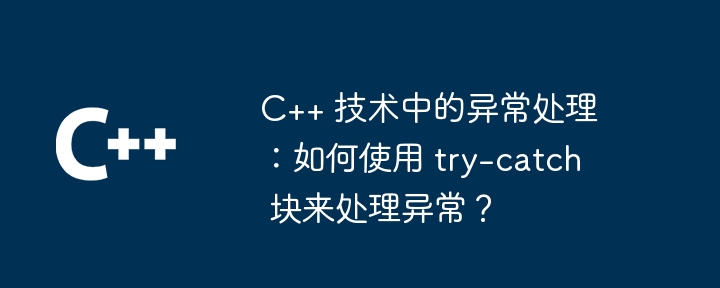Home >Backend Development >C++ >Exception handling in C++ technology: How to use try-catch blocks to handle exceptions?
Exception handling in C++ technology: How to use try-catch blocks to handle exceptions?
- 王林Original
- 2024-05-09 10:42:02692browse
The try-catch block in C is used to handle abnormal events beyond the program's expectations to prevent program errors or crashes. The syntax is: try {...} catch (const exception& e) {...}, where the try block is the code that may throw an exception, and the catch block is the code that handles the exception. Usage tips: Try to use try-catch in functions for exception handling; use specific exception classes to indicate exception types; avoid using empty statements in catch blocks; you can use multiple clauses in catch blocks to handle different exceptions; you can use std:: rethrow() rethrows an exception; using the noexcept keyword to declare a function will not throw an exception.

Exception handling in C technology: using try-catch blocks to handle exceptions
Exception is a kind of exception that occurs beyond the expectations of the program events that may cause program errors or crashes. C provides an exception handling mechanism to handle these exceptions.
try-catch block
The try-catch block is a control structure used to handle exceptions. Its syntax is as follows:
try {
// 可能会抛出异常的代码
} catch (const exception& e) {
// 处理异常的代码
}Practical case
The following is a code example that uses a try-catch block to handle file opening exceptions:
#include <fstream>
#include <iostream>
using namespace std;
int main() {
ifstream file;
try {
file.open("test.txt");
if (!file.is_open()) throw runtime_error("文件打开失败");
// 文件处理代码
file.close();
} catch (const exception& e) {
cout << "异常消息:" << e.what() << endl;
}
return 0;
}In In the code, we first try to open the file. If the file fails to open, it will throw a runtime_error exception. We catch the exception in a catch block and print the exception message.
Use tips
- Use try-catch blocks in functions for exception handling whenever possible.
- Use specific exception classes to indicate specific exception types.
- Avoid using empty statements in catch blocks.
- A catch block can contain multiple catch clauses to handle different types of exceptions.
- You can use
std::rethrow()to rethrow an exception. - Use the
noexceptkeyword to declare that a function will not throw an exception at compile time.
The above is the detailed content of Exception handling in C++ technology: How to use try-catch blocks to handle exceptions?. For more information, please follow other related articles on the PHP Chinese website!
Related articles
See more- What are the forms of python exception handling structures?
- Detailed explanation of Python exception handling mechanism
- Finally successfully used whoops to take over the exception handling of tp6!
- An article explaining in detail how to handle exceptions in Laravel
- PHP exception handling tips: How to catch and handle multiple exceptions using try...catch blocks

